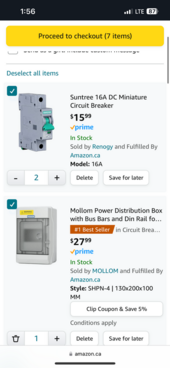Hi Everyone
I bought a half built travel pod trailer and I am finishing /upgrading the solar system and I was wondering if anyone would have a chance to look at a rough wiring diagram I’ve done and confirm what I am doing is okay and answer some of my questions.
As it is now there are 2 100w Renogy panels and a 20amp charge controller . Panels are connected in series but I am going to change them to be in parallel (as suggested by BLUETTI ) .
I just bought blietti eb70s portable power station and a bluetti 200w portable solar panel .
The trailer has a fuse box wired with individual fuses to power A small pump ( max 7.5 amp) , a small fridge ( max 6 amp) and some lights,fans and usb outlets.
I plan to mainly power the fridge independently of the trailer system with the bluetti power station but I want to option to be able to power it with the trailer system too .
The plan is to have it so I can switch between the existing 12v car battery and the bluetti power station to power the trailer system and so I can charge the bluetti or the car battery with the trailers solar panels .
I am thinking to do this by using xt60 plugs so I can easily switch between the two batteries.
I have done a wiring diagram of what I plan to do but the main things I’m not sure about are :
- I am going to have circuit breakers but i am not sure on the exact type and location . BLUETTI suggested using a15 amp breaker before going into the fuse box and coming from the solar ( as I’ve drawn in the diagram ) but would I need a 20 amp breaker for the battery system as the charge controller is 20 amps ?
Also is a single pole breaker okay ?
I was planning on getting the breakers in the photo attached but they only come in 16 and 32 so would need to get a different type if I use the 20 amp
- would I still need inline fuses on the output cables going from the bluetti and the battery ( see the diagram where I have drawn fuses with a question mark ?)
- Renogy suggest using their 20amp anl fuse between the battery and charge controller , would a standard blade inline fuse be okay here ?
Thanks so much for any help or advice it’s very much appreciated.
I bought a half built travel pod trailer and I am finishing /upgrading the solar system and I was wondering if anyone would have a chance to look at a rough wiring diagram I’ve done and confirm what I am doing is okay and answer some of my questions.
As it is now there are 2 100w Renogy panels and a 20amp charge controller . Panels are connected in series but I am going to change them to be in parallel (as suggested by BLUETTI ) .
I just bought blietti eb70s portable power station and a bluetti 200w portable solar panel .
The trailer has a fuse box wired with individual fuses to power A small pump ( max 7.5 amp) , a small fridge ( max 6 amp) and some lights,fans and usb outlets.
I plan to mainly power the fridge independently of the trailer system with the bluetti power station but I want to option to be able to power it with the trailer system too .
The plan is to have it so I can switch between the existing 12v car battery and the bluetti power station to power the trailer system and so I can charge the bluetti or the car battery with the trailers solar panels .
I am thinking to do this by using xt60 plugs so I can easily switch between the two batteries.
I have done a wiring diagram of what I plan to do but the main things I’m not sure about are :
- I am going to have circuit breakers but i am not sure on the exact type and location . BLUETTI suggested using a15 amp breaker before going into the fuse box and coming from the solar ( as I’ve drawn in the diagram ) but would I need a 20 amp breaker for the battery system as the charge controller is 20 amps ?
Also is a single pole breaker okay ?
I was planning on getting the breakers in the photo attached but they only come in 16 and 32 so would need to get a different type if I use the 20 amp
- would I still need inline fuses on the output cables going from the bluetti and the battery ( see the diagram where I have drawn fuses with a question mark ?)
- Renogy suggest using their 20amp anl fuse between the battery and charge controller , would a standard blade inline fuse be okay here ?
Thanks so much for any help or advice it’s very much appreciated.
Attachments
Last edited:












